Why we’re ran it: Plug-in 330e will overtake 320d as the biggest-selling 3 Series. We found out if it could match the diesel’s all-round appeal
Month 5 - Month 4 - Month 3 - Month 2 - Month 1 - Prices and specs
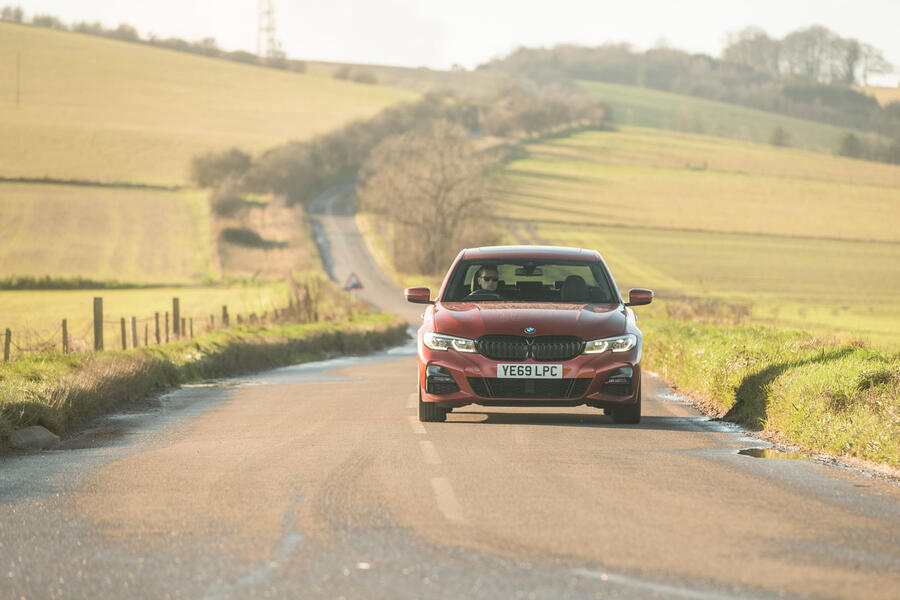
Life with a BMW 330e: Month 5
Did this plug-in hybrid offer the best of both petrol and electric worlds or is it a tax-motivated real-world compromise? - 26 August 2020
Of all the first drives, road tests and long-term test reviews on our website this year, these reports on the 330e stand alone as the most read.
Not the new Land Rover Defender, the latest Porsche 911 Turbo or the all-new Volkswagen Golf, but a variant of the 3 Series that’s been on sale for a couple of years already. Remarkable, isn’t it? I’m humble enough to admit it’s unlikely to be for any Hemingway-aping qualities of the author, but rather an example of just how much interest there is in the wider car-searching internet world in all things electrified, and company car tax-friendly motors such as this 330e.
The 330e’s arrival couldn’t have been better timed. The company car tax bands were completely rewritten in April in favour of electric cars and plug-in hybrids. As a result, the 330e’s CO2 rating of 32g/km and electric-only range of 35 miles attract a benefit-in-kind (BIK) rate of just 10%, a saving of £958 per year for a 40% taxpayer over the previous tax year. Meanwhile, the old company car stalwart, the 320d, attracts a 27% BIK rate. Not much of a decision to make, then, for the company car buyers who hoover up the majority of 3 Series sales. (About 35,000 3 Series are sold a year in the UK, around six in 10 to fleet buyers, and almost all 330es go to fleets.) And nothing we’ve found in living with one for the past few months should deter a company car driver from making this their 3 of choice.
At this point, it’s worth clarifying that for a private buyer, the higher initial cost of the 330e over petrol and diesel 3 Series makes it a questionable purchase over the likes of the 320i and 320d. Intriguingly, though, BMW says the more potent petrol versions like the M340i do particularly well with private 3 Series buyers, which is always nice to hear.
But for those company car drivers, we found the disadvantages over the 320d are tiny and far outweighed by the gains. Fitting the 330e’s 12kWh battery behind the rear seats does rob some boot space and shrinks the fuel tank from 59 to 40 litres. This means you’ll fill up more frequently when the combined range (just under 30 electric miles in the real world and then about 350-400 miles from the petrol tank) is used. And the extra weight of the hybrid system takes a touch off the 3 Series’ outstanding dynamic prowess, but it remains class leading in this regard.
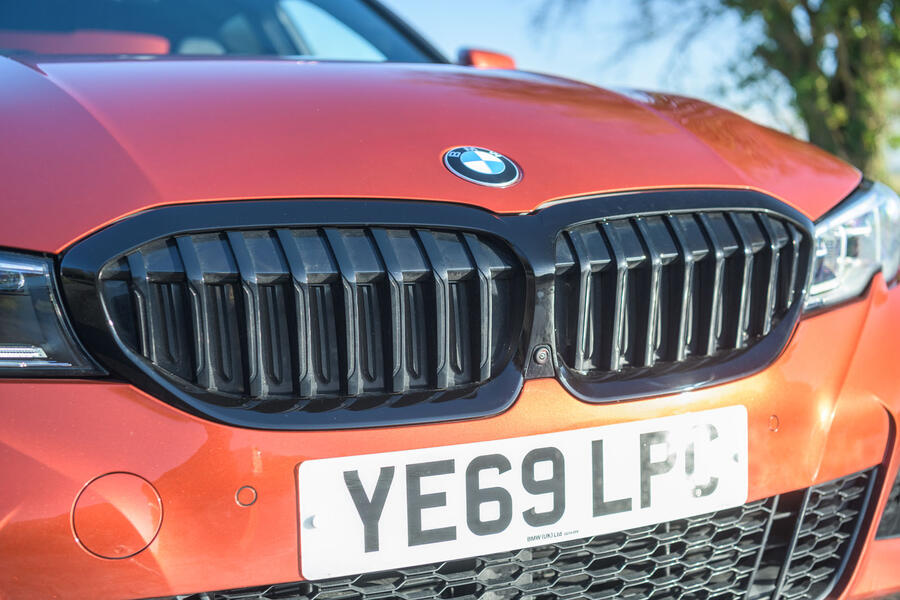
Those gains, then – of which the chief one is the multifaceted hybrid drivetrain. You could, of course, just get the 330e purely for tax reasons and leave the charging cable in the cellophane wrap in the boot, but that’s not cool. Besides, there’s real pleasure to be had from the quiet, refined brilliance of driving around solely on electric power.
And we did a lot of that. Of the 6203 miles we travelled in the 330e, 2892 were solely on electric power. That’s higher than I thought I’d do and I can recall many journeys when just five more miles of range would have returned me to the charger without having turned the engine on.
Before you know what happened in March, I was commuting to the office for 28 miles each way most days, and I could charge at either end. Cold weather could push the range closer to 20 than 30 miles, but commutes were mostly engine free. On resumption of driving after the car was furloughed on the driveway for a couple of months, most of my miles became solely electric while working from home. In fact, I’ve put petrol in it only three times since March, and one of those was a splash and dash.
When the charge runs out, the switch to petrol power is seamless. You can cruise along as happily as in any other 3 Series, and you’ll get about 42mpg on a long, electric-free run like this. Combined economy over its time with us between the two power sources has been an indicated 76mpg.
Numbers-wise, a full charge of the battery cost me £1.30. So ignoring the fact that I was charging at work for free at the start of the year, let’s say I paid for all those charges and got an average of 25 miles from a full charge. That means those 2892 electric miles cost me just £150.38. The petrol cost me £474.74. Let’s say you did the same miles in a 320d and got 50mpg: those same miles would cost you £704.99. So you’re not just saving on tax, but on running costs, too, if – and it’s a big if – you have the ability to charge at home and work, and not all your journeys run into triple-digit mileages pounding up and down the country every day.

As mentioned, the extra weight over a non-hybrid 3 Series takes a percentage point or two off the handling, and more off the secondary ride, particularly at the rear over speed bumps, although the large, 19in alloys and low-profile run-flat tyres of our fully loaded M Sport test car also contribute to that. This is a case of less is more when speccing your 330e and it’s also worth knowing that, unlike the 330i and 330d, the 330e in this range-topping M Sport trim will only come on run-flats from the factory and you have to have SE Pro to get non-run-flat 17s. Yet dynamically, as our recent 4.5- star road test confirmed, it beats all plug-in hybrid saloon rivals and most other executive saloons besides.
I’d consider myself a good target market for a plug-in hybrid: I drive for work, do frequent small trips to make full use of the electric power, can charge at home and work, and do weekly-or-so longer trips to dip into the fuel tank. And in the 330e, we’ve found the best of the lot.
Second Opinion

I drove the 330e only a few times, but we always seemed to encounter conditions where it could show it strengths: lovely steering, perfect handling balance and excellent body control when you press on. I’d not been so familiar with recent smaller BMWs when it arrived, so it was great to discover the marque’s reputation for special driving machines was well and truly intact.

Steve Cropley
Love it:
Refinement This is one quiet, calm and relaxing car to drive, yet still with a serious dynamic edge, too.
Performance Select the XtraBoost driving mode for the full 289bhp and fairly devastating real-world pace.
Infotainment Retaining physical buttons and controllers over a touchscreen is welcome: the 3 Series has no peers.
Loathe it:
Small boot Battery robs about 25% of usable space over a non-hybrid 3. The 330e Touring sounds tempting…
Secondary ride Rear can crash its way over speed bumps, the battery’s weight and low-profile tyres exacerbating it.
Final mileage: 6995
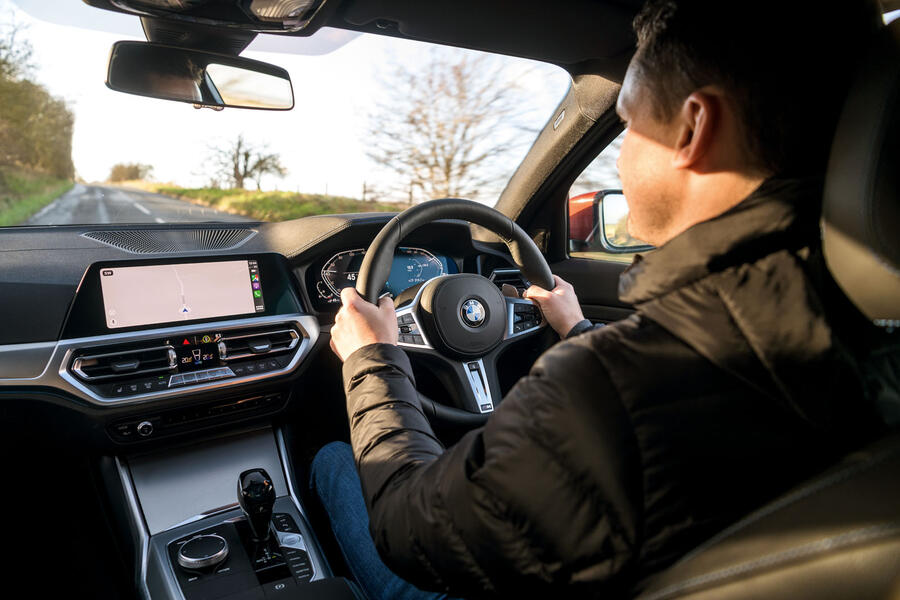
A bump in the road - 12th August 2020
A local road closure has meant a diversion over a route covered with speed bumps, the severity of which the 330e does not enjoy. Its big wheels and run-flat tyres, combined with the weight of the hybrid system, particularly the battery over the rear axle, bring a harshness to the ride that makes you wince by the time the bumps are in double figures.
Mileage: 6846
Life with a BMW 330e: Month 4
plug placement conundrum - 15 July 2020
Knowing the location of your car’s charging port is important: park wrong and your charging cable won’t reach. Car makers have put ports in the front or back bumpers, front wings or where the old fuel pump used to go. I like backing into spaces, but the 330e’s nearside front wing port precludes that for some chargers I’ve found. Frustrating.
Mileage: 5842

Keeping cool can be complex - 8 July 2020
I’ve noticed during the recent hot weather that BMW buries the air-con on/off button within a menu on the infotainment screen. There’s an ‘AC menu’ button on the centre console but, once you’re there, there are about five other menus you could be taken to, depending on which was last open. It’s distracting and never easy to remember the right one.
Mileage: 5787

Our ultimate parked machine is finally, once again, the ultimate driving machine - 17 June 2020
Your eyes do not deceive you: the 330e’s odometer has at last started going upwards once more after two months of the car being furloughed in the driveway. Easing lockdown restrictions by allowing us to drive places for exercise has opened up a life of greater excitement for our dog in particular. She had run out of lamp posts to sniff around the block and can now be transported by BMW to sniff other lamp posts a bit further away.
The 330e started first time (not sure why I was surprised; why wouldn’t it?) and, after some checks, all seemed safe, drivable and exactly as I’d left it, right down to the amount of battery left in the hybrid system, which impressively had not dropped at all in that time.
Driving again was a quite remarkable experience. You’re suddenly so much more aware of everything. All the senses are stirred in a way they’d come nowhere close to in two months of nothing more than walking pace. It was almost spiritual, as strange as that sounds, in rediscovering just how joyful and liberating the simple act of driving can be. Every steering input, touch of the pedals, even flick of the indicator brought a refreshing return to normality. Funny the things you miss. What’s that saying? You don’t know what you’ve got till it’s gone?
In the 330e, it was like making first impressions all over again. In the default mode of electric-only driving when there’s charge in the battery, I’d forgotten just how much torque there is. I’d forgotten how big and squidgy the steering wheel is and how good the steering feels. I don’t remember sitting as low (too many SUVs ingrained in the subconscious, probably) but loved the fact that my bum was close to the ground.
I also loved how empty the roads were. The lockdown, along with an enforced period of home working, has put many driving-related things into perspective: chiefly, just what is the point of the rush hour, that twice-daily nuisance that blights our roads? Driving traffic-free on roads out of town that are normally so congested was about as much fun as I’ve had in 30mph suburbia, simply because I was able to make unobstructed progress.

After a few local trips, we ventured further afield, dog in tow, to a quiet part of the south coast. (Don’t worry, Daily Mail: not all of us sit on Bournemouth beach.) I thought a greyhound and a saloon wouldn’t be the best match, but stuff the rear footwells with cushions, lay a mat over the top and there’s plenty of space. She seemed happy enough.
The longer drive showed even more of the 330e’s all-round appeal: when the battery runs out, the petrol engine takes over. The range of the car is a real boon and, as detailed previously, if you do enough short journeys and can charge it often, you can get close to four figures out of a tank, as I have. You can also do stints of two hours or more behind the wheel and not be in the slightest bit of discomfort, even not having done a long drive for so long.
Driving, then. Quite fun, isn’t it? Oh, how we’ve missed you. And speaking of things to miss, if you’ll excuse the indulgence, a former resident of these pages in 2014-2015 has remained on my driveway ever since, after I took on the ownership: a Mini Cooper. Even now, it still feels like a baby BMW in its usability yet with those fun, famed Mini dynamics. But now it’s time to say goodbye to it once and for all because, by the time you read this, it will have been replaced by a Ford Fiesta to park next to the 330e each night. Just as the Mini has given many years of happy motoring, the 330e feels like the car to do just the same.
Love it:
Driving Yep, that’s it: just driving. And to have the pleasure of doing so in a 3 Series makes it all the better.
Loathe it:
small boot I’ve grumbled about this before, but I’d forgotten just what a weird shape (long and thin) and how limiting the 330e’s boot is.


Mileage: 5397
Live with a BMW 330e: Month 3
Our colourful car is the exception - 20 May 2020
Funny what you notice when you’ve got more time on your hands to look at cars rather than drive them. The latest news from 330e lockdown land concerns colour. Stick with me… Some 60% of new cars sold in this country last year were grey, white or black. How dreary. Our 330e, with its Sunset Orange hue, wasn’t one of them. Just when and why did Brits get so unadventurous with car colours? But then I started noticing other 3 Series, and monochrome seems an exception rather than a rule. Blue, red and, yes, orange like mine: brightly coloured 3 Series seem to be more common than the dull ones. Or maybe they just blended in with all the others on the road. Just me?
Mileage: 5104
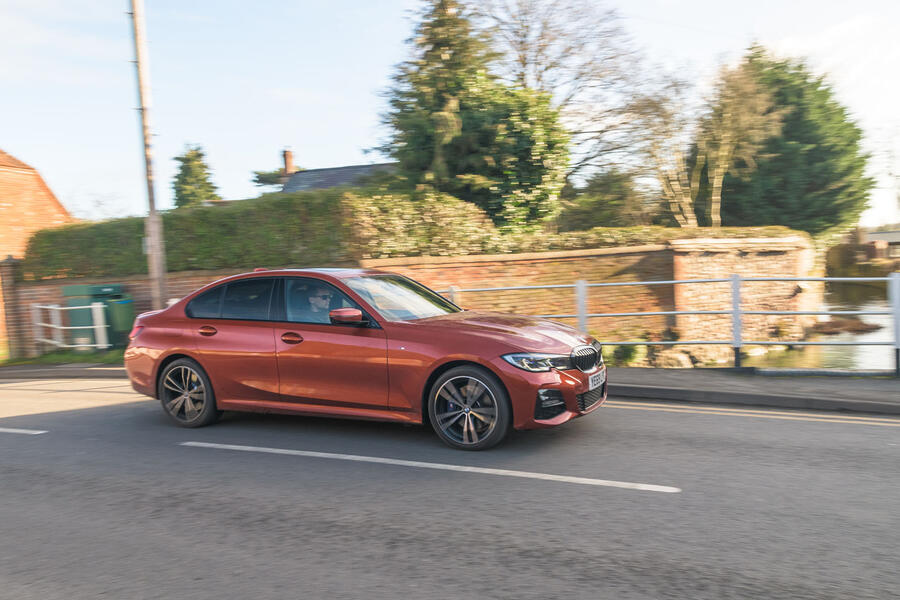
Even when it’s not going anywhere, our plug-in hybrid has a fascinating story to tell - 6 May 2020
The keenest-eyed readers will have noticed that the mileage reading hasn’t nudged at all since the last update, because not even a short drive to Tesco is in order for your correspondent when living opposite a very well-stocked small shop, its excellent range of products including this very magazine…
Yet the 330e’s current dormancy has allowed for plenty of number crunching and reflections on what we’ve learned about this most fascinating of 3 Series now the 5000-mile milestone on the odometer has come up. Chiefly, the 330e’s continued kindness to your wallet and why it can make a lot of financial sense in running costs as well as in saving tax for company car buyers.
As we said right at the very start of these reports, plug-in hybrids should not be seen as the right choice for everyone. Those who do big miles will still want a diesel and private buyers who do fewer miles a petrol, but fleet buyers who don’t travel the length and breadth of the country and can charge either at home or work – or ideally both – will see a big benefit not only in tax bills but in fuel costs, too.
So that latter way has proven for us. Of those 5103 miles, the first 792 were done before BMW handed us the keys. But of the 4311 miles in our ownership, 2254 have been done solely on electric power, so just over half in total. That’s because I can charge at home and work, and my commute of about 28 miles each way is almost exactly in line with the 330e’s real-world battery range.
I’m doing (or rather was doing) longer journeys that rely mainly on petrol power on average about once every five to seven days, which has meant infrequent trips to the fuel station. Even with the smaller petrol tank (40 litres in the 330e, compared with 60 litres in non-plug-in hybrid 3 Series), I’m getting about 400 miles from that tank on pure petrol power.

So you’re looking at about 800 miles between fills with my combined petrol and electric usage (the record being as high as 1100 miles when I didn’t venture too far off the commute one fortnight), compared with the 627 miles between fills we got from the previous-generation 320d that was in our ownership from 2016 to 2017.
That 320d averaged just under 50mpg in its time with us, which compares with the combined 76.5mpg being shown on the 330e’s trip computer in its time with us so far. Many company car drivers would be happy with the two-thirds cost saving in tax of a 330e over a 320d but, again with the caveat of being able to charge for as long as you can as frequently as you can, we’re finding that there is even greater overall efficiency to be had, as well as fewer visits to the fuel station needed, saving more time and money.
And if all that charging sounds a chore, surprisingly it isn’t: it simply becomes a habit and takes no more than 30 seconds at the beginning or end of a journey. Admittedly, dragging big awkward cables off the ground on a cold wet morning isn’t the most premium thing in the world, but get into the pre-conditioned cabin (toasty warm in the winter, nice cool air-con in the summer) and pull away in silence while enjoying that instant torque under your right foot and you’ll not even be bothered by that after a short while, either.
Love it:
The 3 Series’ looks It’s not the greatest 3 Series yet seen, but it’s got plenty on BMW’s other recent range additions.
Loathe it:
Static presence I miss driving it. I’d give plenty even for a traffic jam on the approach to the M3 motorway right now…
Mileage: 5103
iDrive gets our vote - 22 April 2020
There wasn’t tons of praise lavished on the BMW 2 Series Gran Coupé in our recent road test, but one positive was its infotainment system. Which is familiar, of course, from the 330e. One bit in particular struck a chord: the approval of the rotary controller and shortcut buttons that make “the system that much easier to operate while on the move”. The more miles I do in the 330e (not too many right now, admittedly), the more that praise rings true. It’s so much faster, more intuitive and safer to use the controller than any touchscreen. The tide is turning somewhat against touchscreens and how much of a distraction they can be by taking your eyes off the road. BMW already has the answer.
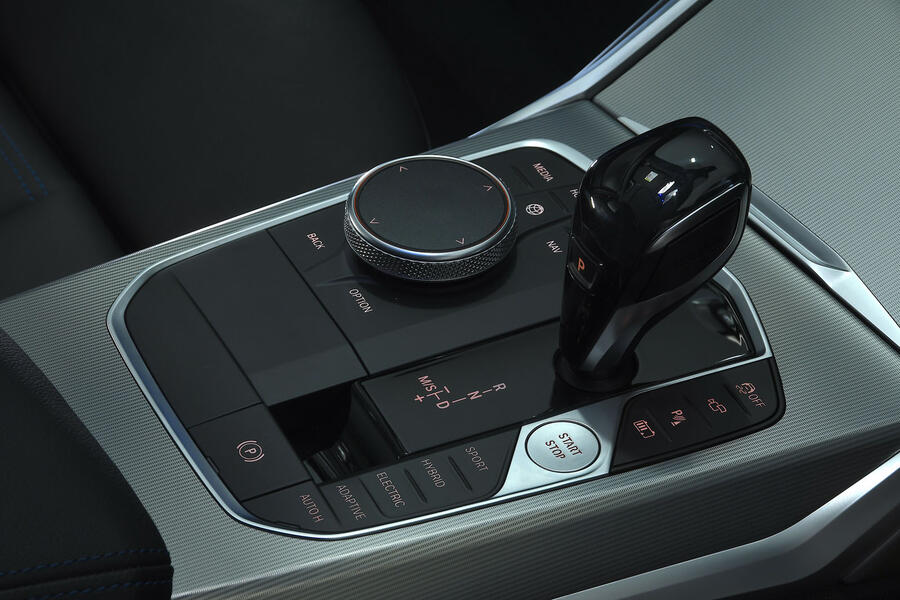
Mileage: 5103
Life with a BMW 330e: Month 2
Our 3 Series is proving both environmentally and driver friendly - 8 April 2020
While SUVs may seem to be taking over the world, when you look at the sales charts and the traffic on our roads, the BMW 3 Series is still showing just how important and relevant saloon cars are.
As I’m discovering after recent extended stints in many an SUV, driving a saloon makes you feel so much more involved in the drive. There’s something about sitting low with your bum on the floor and having your legs near-horizontal that allows you to become really immersed in the experience. Things just come easily and with an air of familiarity. And no saloon does it better than the 3 Series, whether it’s this plug-in hybrid 330e or any other version.
BMW now offers far more SUVs than it does saloons, but the relevance and significance of the 3 Series is as strong as ever. “A typical 3 Series year in the UK is 35,000 units, and volumes have stayed stable even as the BMW X3 and BMW X4 have risen,” says BMW UK’s James Thompson, the product manager for all models with a 3 or 4 in their name. “The 3 Series is as important as ever, and buyers have stayed with it.”
For many buyers, it’s not just the quality of the car that attracts. The dominance of SUVs is felt mainly in the private retail sector (which makes up 43% of new car sales in the UK) but, in the fleet market (55% of sales), it’s saloons and other ‘low’ cars that continue to appeal, due to their lower CO2 rating.
“The corporate world is still dominated by saloons and estates, not SUVs,” says Thompson. “The CO2 is lower and most fleets won’t put you on the list if you’re over 130g/km.”
The 3 Series sales are split 40% to retail, 60% to the corporate sector. While CO2 rules are changing so much of the car world as we know it, they’re also ensuring that such a well-loved bodystyle as the saloon can continue to survive and thrive.
Mileage: 5102
Boot takes a hit - 1 April 2020
Having both an electric-only range and a fuel tank of substance means that something has to give in terms of packaging. It’s easy enough in an SUV, with extra room in the floor, but not so in a saloon like the 3 Series. So it’s boot space that suffers, fitting only a couple of weekend bags for two humans and a dog and all the wires for charging the battery.
Mileage: 4612
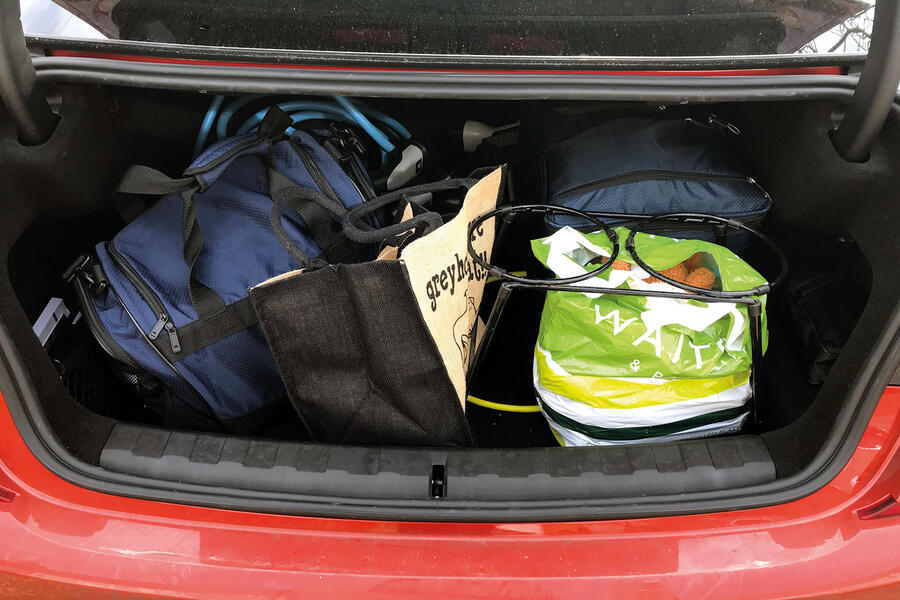
Our plug-in hybrid saloon is great to drive but tricky to operate - 25 March 2020
So what is it actually like to drive? You’ll forgive me for only getting to answer this question now, in the third meaty report on the 330e. So rarely has a car needed so much scene-setting and prep, first to find out if it can actually be used as its maker intended, and second to learn how to use it yourself. Clearly this is nothing like the simple-to-use familiarity of having a 320d…
Charging points installed, hybrid tech learned and company car tax bill calculated, and it’s onto living with the car. And for the most part, it won’t surprise you to learn that the 330e is proving much like any other 3 Series.
It steers with an accuracy some bona fide sports cars can only dream of, and it is one of those cars that has the ability to make the most mundane and routine of journeys an enjoyable experience – and that’s simply down to everything the driver interacts with being engineered with the pleasure of driving in mind. That was true the last time we had a 3 Series at Autocar, a previous-generation 320d xDrive M Sport version back in 2016. That car also became a firm favourite for the way it could make every drive so pleasurable. An evolutionary approach has been adopted, then – and why wouldn’t BMW, when it has such a formula licked?
The one major dynamic difference you do notice is the extra weight. The 330e weighs in excess of 200kg more than an equivalent current-generation 320i, due to that electric motor plus the lithium ion battery pack under the rear seats. As such, the 330e doesn’t quite have the fleetfootedness of a 320d in its ability to change direction, yet it still feels more agile than an Audi A4.
The ride also suffers a bit on occasion, with a tendency for the impact of potholes to crash through the cabin, yet I’m not sure how much of that is down to the 19in M Sport alloys of our car. That was true also of the 2016 320d we had on similar-sized wheels, and the two cars also share the optional adaptive M Sport dampers. I’d be keen to try a 330e on smaller wheels and with the standard dampers for comparison, and find out whether the weight or the chassis set-up is to blame.
So the hybrid system doesn’t do anything major to mess with the dynamics of the excellent G20-generation 3 Series, which is, remember, an Autocar five-star road test car in its 320d guise. The changes are, predictably enough, found when you press your right foot to the floor.
This is where it gets a bit complicated. There are so many different ways of driving the 330e and so many modes to put it in, depending on how long your journey is and how you want to drive. These are as extreme as using electric-only mode and having the power reduced to try to preserve as much battery range as possible, or as extreme as Xtraboost mode, which liberates the full 111bhp of the electric motor and the 181bhp of the 2.0-litre petrol.
The point is this: everything needs a button pressed, and there’s no easy way to let the car choose. The normal mode, Hybrid, runs the battery down in the first instance to keep driving on electric power as much as possible, unless you want to save the battery for later or you have a route plumbed into the navigation system, in which case it’ll save the battery for you. So while very clever, even at its most ‘normal’, it’s not that simple.
Love it:
Public chargers Used one for the first time at a Hampshire garden centre that had a dozen free. Got eight miles of range in 20 minutes, gratis.
Loathe it:
public chargers Went to use one at a hotel that had been good enough to install them but not good enough to stop an old BMW X6 and an Audi A4 parking in the spaces.
Mileage: 4221
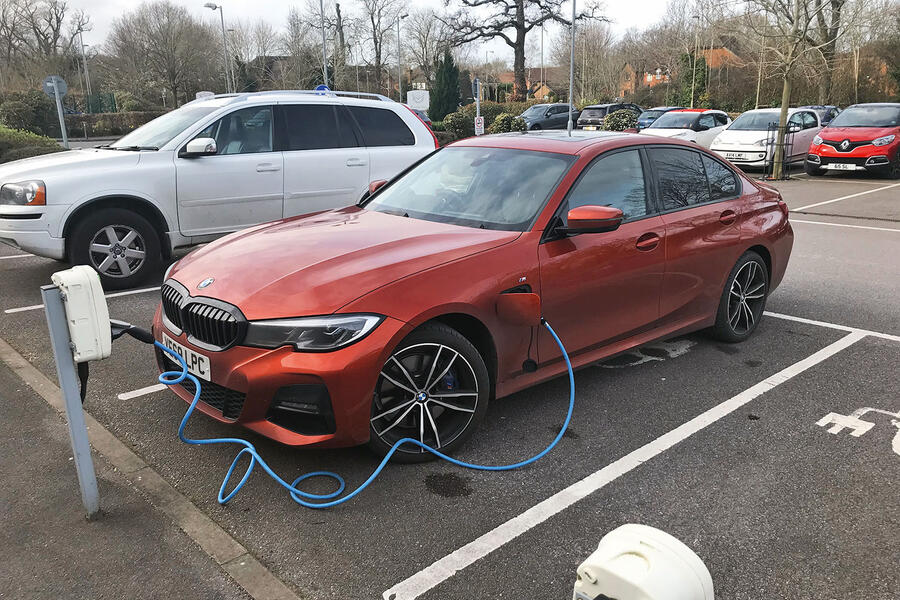
an immediate impression from behind the wheel - 28 March 2020
By rights I ought to be concentrating on this 330e’s excellent, efficient powertrain, but when I drove the car, I couldn’t put aside my obsession with its phenomenal steering: supremely accurate, perfectly weighted and geared, with a wheel of ideal diameter and rim size. Who, I kept wondering, can be enjoying a better steering system? My answer: nobody, even at treble the money
Steve Cropley
Mileage: 4093
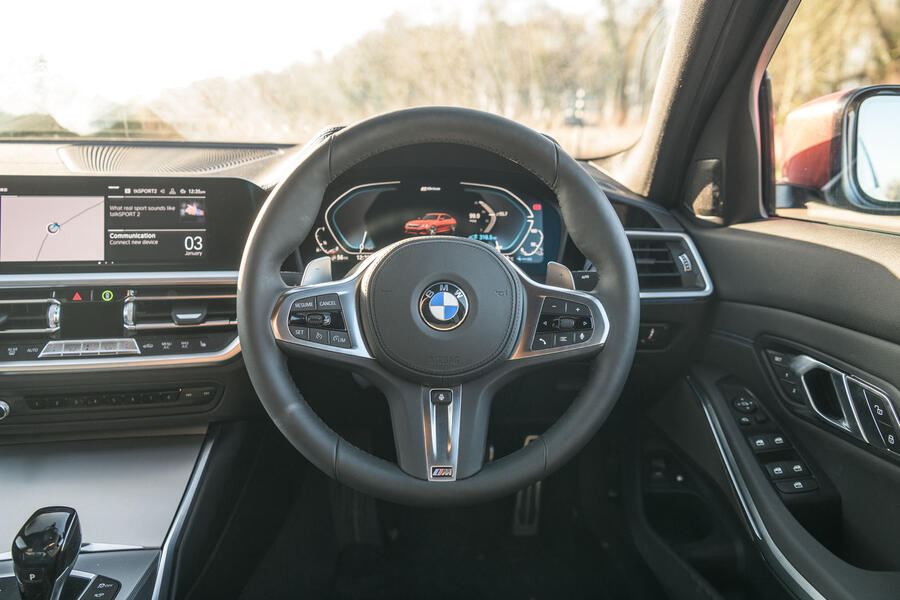
Petrol power can still impress - 4 March 2020
My commutes are mostly electrically powered only, but longer trips bring the 2.0-litre petrol engine into play. At motorway speeds, it feels like any other 3 Series. It’s quiet and refined, and with a mid-range boosted by the electric motor’s torque. Oddly, the faster you go, the more economical the petrol engine becomes – up to a point. You’ll see 50mpg at 70mph running on petrol power alone.
Mileage: 3446

Life with a BMW 330e: Month 1
Electric-only commuting is now possible in both directions – conditions permitting - 26 February 2020
The company car tax benefits of plug-in hybrids like the BMW 330e are such that instances of them being returned with the charging cables in the boot still in the Cellophane wrapper still occur, admits BMW.
But that is becoming a rarer occurrence, and in my entry for understatement of the year, you need to be charging your plug-in hybrid to get the most out of it. You could just drive it and never charge it, but then you’d be struggling to get 35mpg from a 2.0-litre petrol 3 Series with a load of extra weight you’re making no use of, plus a much smaller fuel tank that means you’ll be stopping to fill up with fuel more often anyway.
With an electric-only range that sits between about 20 and 25 miles with the cold weather at this time of year (the official range is 35 miles), the 330e needs to be charged quite frequently and driven on electric power for as long as you can to really get the most out of it to save money on fuel as well as in tax.
My commute is between 25 and 30 miles in each direction, depending how bad the traffic is on any given route, so I can tackle it almost entirely on electric power and feel a bit of a poster child for the effective use of a plug-in hybrid, given that the longer journeys I undertake at the weekend mean I’m also making use of the petrol engine. I’m able to be said poster child because we have the luxury of charging at work and, as I have a driveway, I can charge the car at home, too. For someone like me, plug-in hybrids are a very sensible and pragmatic solution.
Getting a charging point installed at home was much more straightforward than I thought it would be and was explained to me by the BP Chargemaster fitter in electricity terminology that even my limited DIY ability allowed me to understand. I’d had my fuse box upgraded last summer, leaving a spare connection for a charging point to be hooked up to and given its own switch on the consumer unit.
The BP Chargemaster Homecharge unit I went for typically costs £449, assuming there are no special requests or circumstances that deviate from what should be quite a straightforward installation.
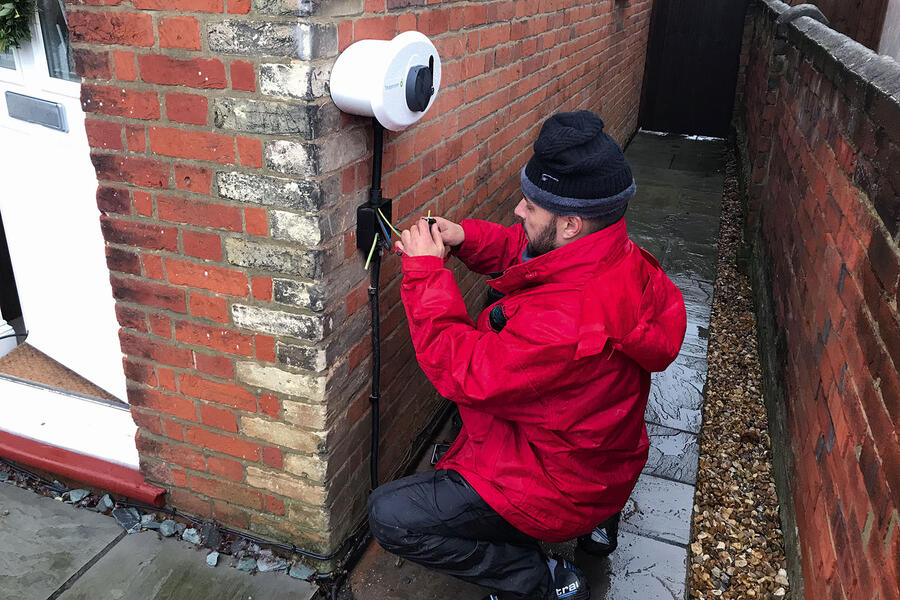
That figure is after a £500 grant from the government’s Office for Low Emissions Vehicles’ Electric Vehicle Homecharge Scheme. Put simply, anyone getting an electric or plug-in hybrid car can get that grant, and up to two per household are allowed should there be two qualifying cars per household. The BP Chargemaster unit is a 7kW charger (which I went for), but it can fit a 3.6kW if your property’s power isn’t sufficient.
You can choose where the Homecharge unit is fitted – I went for down the side of the house – so long as an earthing rod can be fitted in the vicinity (and your car’s charging cable can reach, which in the case of the 4.5m-long cable offered in the 330e and the charging point being located on the front wing, requires reversing as close to the house as I can get).
All in, installation took about two hours, and the 330e can now have its 12kWh battery fully recharged on my drive in about two and a half hours, at a cost of about £1.30 on my current electricity tariff. On that point, you can get tariffs now that give you cheaper power overnight specifically with charging your electric or plug-in hybrid car in mind.
BP Chargemaster offers an app that lets you track how much you’re spending. BMW also has one that allows you to precondition the car ahead of your chosen departure time so long as it’s connected to the charger – ideal for making the cabin toasty warm and the glass frost-free on the cold winter mornings we’ve had so far.
That’s now two chunky reports on the 330e and I’ve hardly said anything about actually living life with the car itself. That’s not posturing: it simply goes to show just how much there is to get used to with the car, and how much preparation is needed in advance to make sure it’s a sensible choice for you in the first place, and then know what you need to do to get the most from it as soon as it arrives. Seeds now sown.
Love it:
BMW connected app Great for checking battery and fuel tank range – and turning on the climate control to defrost the car.
Loathe it:
Engine cutting in Driving on electric power is so quiet and soothing that it’s a shame to be interrupted by the petrol engine.
Mileage: 3289
Maximising range the right way - 12 February 2020
Early journeys show how similar the 330e is to other 3 Series, yet also such a new experience. Be aware of your journey length and battery range to truly maximise efficiency. Never charge it and drive it like any other 3, and you’ll only get about 40mpg. Charge it often and you’ll cover many miles on electric power alone and average nearly 70mpg.
Mileage: 2999

Welcoming the 330e to the fleet - 5th February 2020
The BMW 330e comes with a lot of interesting numbers. There are the impressive performance figures (288bhp, 0-62mph in 5.9sec). Plus there are the official economy and CO2 figures (176.6mpg, 36g/km). Those then feed into the 330e’s real trump card – and its imminent crowning as the best-selling 3 Series in the range: its impending benefit-in-kind (BIK) tax rate of just 10%.
Put another way, come April it will cost a company car driver in tax around one third that of the currently best-selling 3 Series, the 320d, which, says BMW UK, the 330e will quickly usurp in sales. And all that for a car that’s significantly more powerful and which can travel on electric power alone for around 35 miles.
While talk of tax bands and BIK rates is not typical Autocar fare, from April it’s about to become increasingly significant as the government launches new company car tax rules unashamedly designed to increase the sales of electric cars and plug-in hybrids.
Car makers also need to sell ever-increasing numbers of these models to lower their fleet CO2 averages and avoid fines for being over the industry-wide 95g/km fleet average target. Electric cars and sub-50g/ km plug-in hybrids bring a double-whammy benefit of lowering fleet CO2 figures and qualifying for ‘super credits’ that in effect count as two sales in one, in turn allowing BMW to continue making higher-polluting cars such as BMW the M3 without penalty.
Last year some 60% of new cars sold in the UK were to fleets, compared with 48% in 2010, with private car sales dropping from 47% market share to 37% in the same period. Those numbers were mirrored across the 3 Series range, according to BMW UK’s 3 Series product manager James Thompson, further highlighting the 330e’s importance to the German brand. Some 35,000 3 Series will find homes this year, around 10,000 of which will be 330es, and 95% of those 10,000 will go to company car buyers.
If your 330e arrives before the new tax year, you’ll pay either 8% or 12% BIK, depending on with which emissions standard the Treasury wants to correlate the CO2 figure. (You expected the motoring taxation policy to be clearly laid out by now?) Anyway, from 6 April it will be 10% for the plug-in BMW and 0% for pure EVs. Order one now and it won’t be with you before July anyway, so that 10% figure is the most relevant.
This whole topic is one we’ll look at in our news analysis pages in detail in the coming weeks before the tax changes kick in, but take away this for now: company car buyers will be able to save serious money by switching to EVs and plug-in hybrids. And perhaps the best of the plug-in hybrid breed right now is this 330e. It aims to be the 3 Series without compromise, keeping the sporting appeal for which the saloon has always been known but with some attractive cost and economy benefits.

The 330e uses a 181bhp 2.0-litre petrol engine familiar from elsewhere in the 3 Series range. Mounted within its eight-speed automatic gearbox is a 67bhp electric motor (its output increases to 111bhp with an ‘Xtraboost’ function in Sport mode) that powers a 12kWh lithium ion battery. That battery lives under the rear seats, with the fuel tank moving to the boot. The 40-litre fuel tank is 20 litres smaller than that of the non-hybrid 3 Series but results in the 330e’s one key compromise: a 105-litre cut in boot capacity.
The 330e is rear-wheel drive for now; xDrive four-wheel drive comes later this year, when a Touring version will also be introduced. Being rear-wheel drive with a fully integrated electric drive unit means the BMW system is claimed to be seamless in its operation in shifting between electric and petrol power, or a combination of both, as the electric motor sits on the flywheel and isn’t powering an entirely different axle, as is the case with some hybrid systems.
While driving this plug-in BMW is a straightforward process – it can be left in a simple Hybrid setting to leave the car to best decide from which source it should draw power – there are several other driving modes and many more functions to explore, all of which we’ll look at in the months ahead.
While the powertrain may not be as familiar, the specification of our 330e is. M Sport remains a popular trim level for the 3 Series, and it is offered on the 330e alongside entry-level SE and Sport. On top of the M Sport trim, which brings with it the usual array of visual and dynamic sporting upgrades, we have an optional M Sport Plus package that brings bigger 19in alloys, beefier brakes, variable sport steering and, intriguingly, adaptive dampers. This is the first time adaptive dampers have been included in a package – despite typically receiving rave reviews in the media, uptake from buyers had been less than 10%.
It’s rare for long-term reports like this to offer conclusions so early on, but it’s worth pointing out now that the 330e will not be suitable for all 3 Series buyers, specifically private buyers who won’t enjoy the tax benefits of company car buyers.
For them, offsetting the 330e’s list price against the potential money saved in fuel will be negligible, unless nearly all journeys are within the 35-mile electric-only range, at which point you may as well just buy a Tesla Model 3 for very similar money – or a BMW M340i, as Thompson says many private buyers are doing.
Not only is this our first long-term test of a hybrid 3 Series but it is also our first extended taste of a 3 Series in this G20 generation, which has already earned a five-star road test rating in 320d form. Finding out how much of that magic remains in this 330e will make for a fascinating few months to come.
Second Opinion
The 330e has been a favourite of mine since I drove a skinny-tyred Sporttrim version of the last generation. The G20 is quicker and does 20 urban miles on its battery without trying too hard. But, as with so many more modestly powered cars, smaller wheels and less grip makes for more driver appeal.
Matt Saunders
BMW 330e M Sport specification
Prices: List price new £39,860 List price now £41,450 Price as tested £49,300 Dealer value now £34,925 Private value now £31,044 Trade value now £30,125 (part exchange)
Options:M Sport Plus pack £2200, Technology pack £1900, Premium pack £1700, Visibility pack £1500, Comfort pack £990, aluminium mesh effect interior trim £650, Vernasca leather seats £500
Fuel consumption and range: Claimed economy 201.8mpg Fuel tank 40 litres Test average 75.9mpg Test best 84mpg (combined, after battery is drained) Test worst 41.0mpg Real-world range 365 miles petrol, plus 25 miles battery
Tech highlights: 0-62mph 5.9sec Top speed 143mph Engine 4 cyls in line, 1998cc, turbocharged, petrol, plus AC synchronous electric motor Max power 289bhp at 5000-6500rpm Max torque 310lb ft at 1350-4000rpm Transmission 8-spd automatic Boot capacity 375 litres Wheels 8.0Jx19in (f), 9.0Jx19in (r) Tyres 225/40 R19 (f), 255/35 R19 (r), Bridgestone Turanza T005 Kerb weight 1740kg
Service and running costs: Contract hire rate £389 CO2 32g/km Service costs None Other costs None Fuel costs £474.74 petrol, £150,30 electricity Running costs inc fuel £625.12 Cost per mile 10 pence Depreciation £9735 Cost per mile inc dep’n £1.67 Faults None



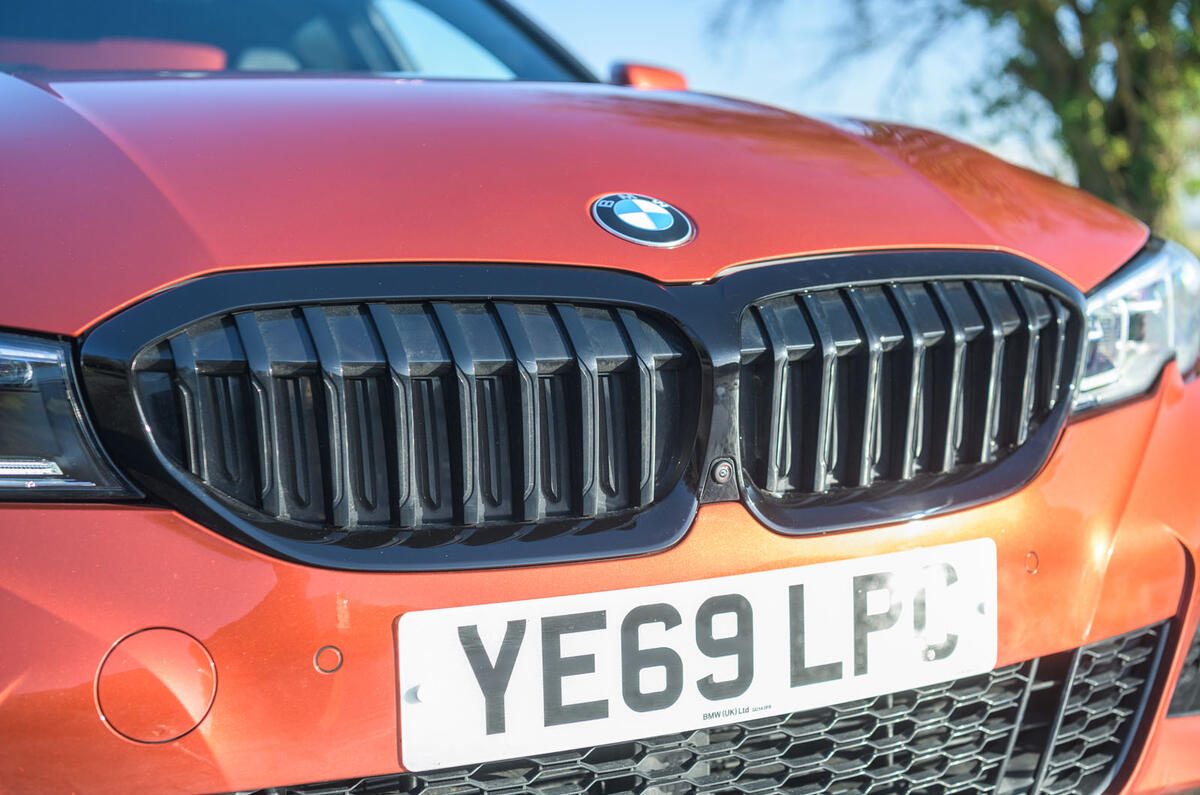











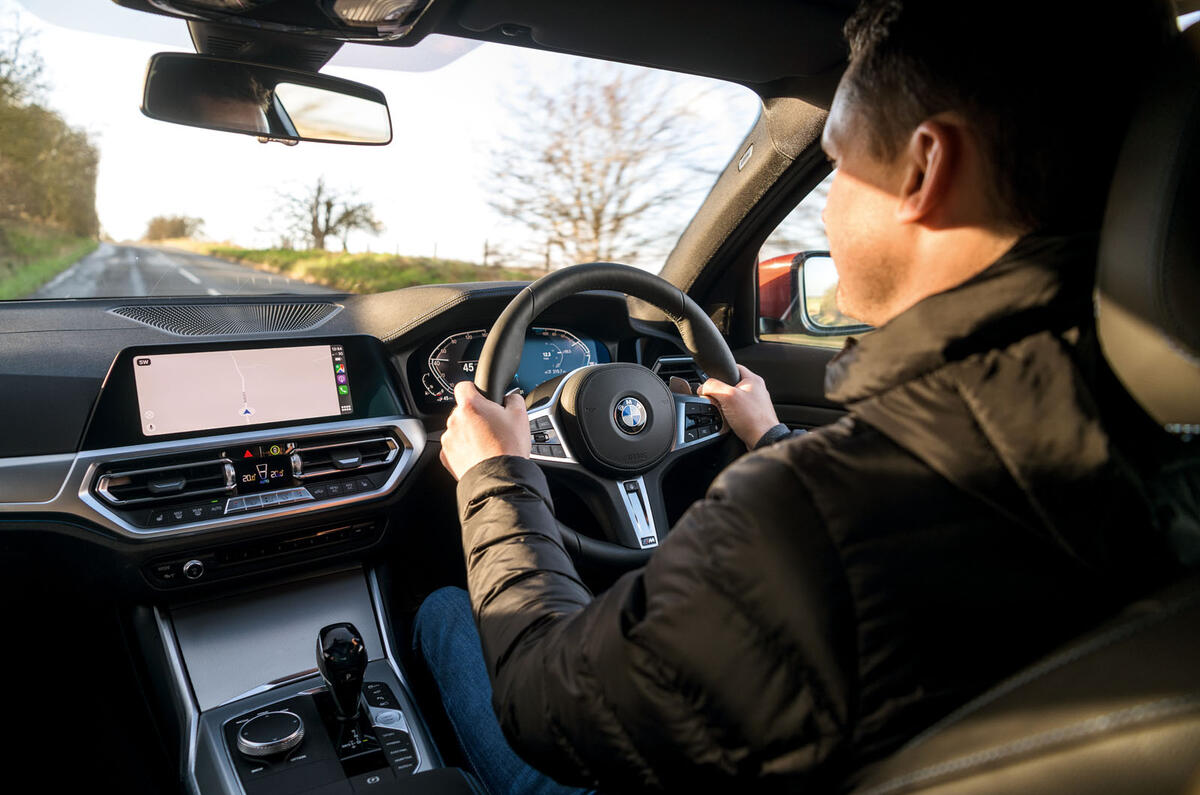
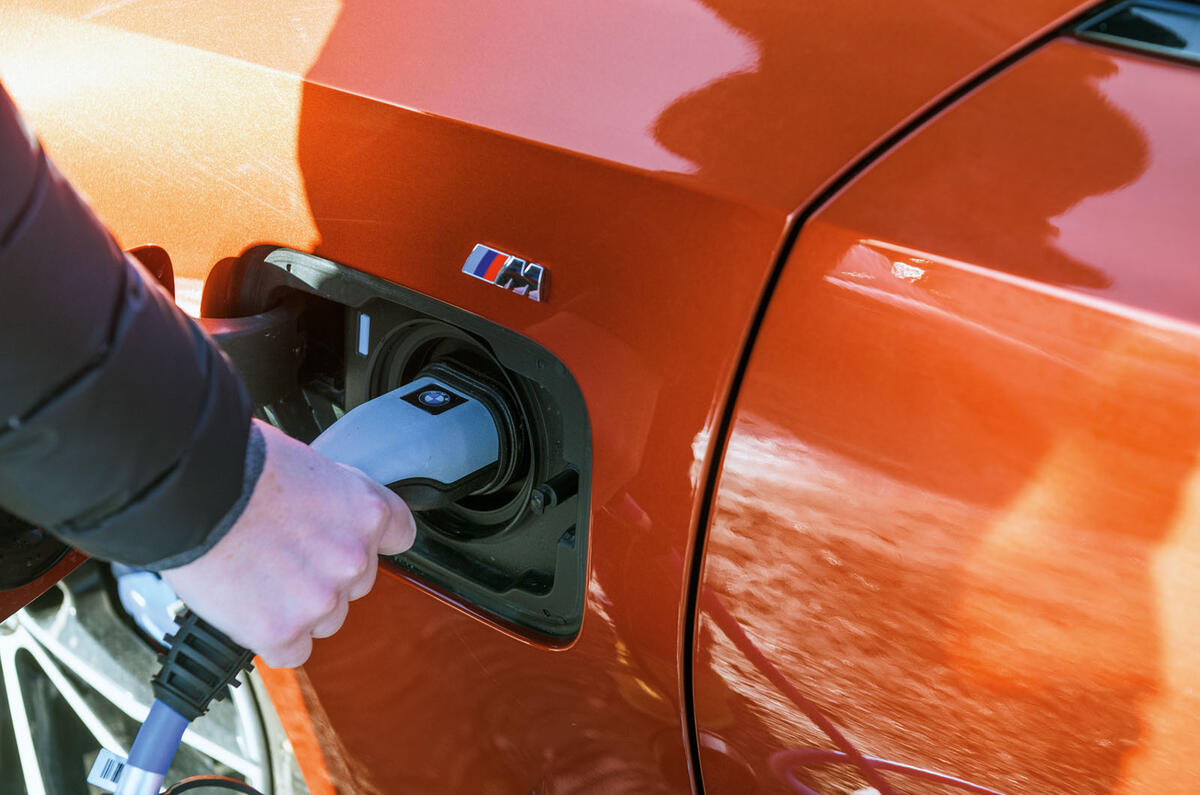
























Join the debate
Add your comment
Instrument layout is cluttered, fiddly, high beam light placed out of sight behind left hand at 10to2 position. Too many layers of silly menus. How about a simple trip meter in front of the driver. Switch gear is hidden or confusing where it does exist. Fog lights impossibly placed under the steering wheel. Cruise control a mass of fiddly buttons on the wheel instead of being operated with the flick of a stalk.
The car is chatty, way too chatty. I don't want non-urgent messages constantly popping up while I'm driving
BMW Connect doesn't work without a mobile signal, so next to useless in much of the English countryside. If BMW could make it connect to WiFi it would be more useful.
Electricty charges are now so high that only an off-peak tariff is still viable, still a little bit cheaper than petrol but anyone using a public EV charger is wasting money.
Despite the whisper quietness of the electric motor, I find the switch to the petrol engine is almost imperceptible, seamless. The petrol engine makes so little noise it's barely discernable except when driving it hard. Perhaps you got a Monday car.
320i vs 330e
Kinda torn between 320i vs 330e. I know the answer is right there but I just couldn't pull the plug.
PHEV using petrol engine
I have always understood that you shouldn't use maximum power before the car engine is at working temperature. I had an Alfa Romeo that had a warning light that didn’t go out until the engine was at working temperature and that maximum power could be used.
Yet this 330e, and presumably most other hybrids, start up the engine when the driver is demanding high power. You are then running a cold engine at near maximum power. Any comments?
Martin
+1, I've said it myself before, and it's probably worse in a diesel PHEV. Also, do they have elecrtic heaters instead of the normal coolant water from the engine providing heat, anyone know?